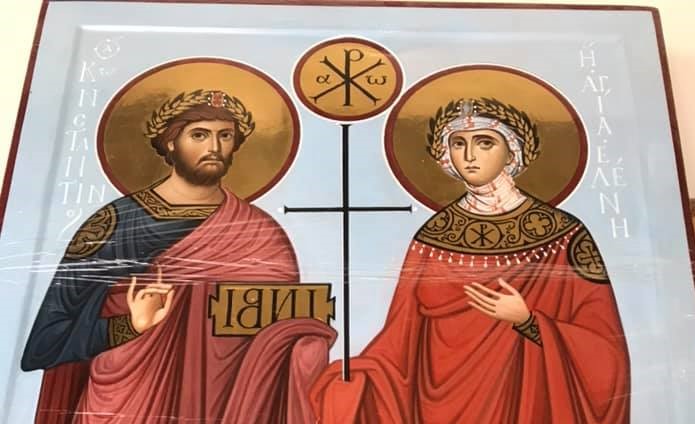The Church celebrates the memory of Holy Great Sovereigns Constantine and Helena, Equal to the Apostles.
Saint Helena was born in Drepanum, in the province of Bithynia in Asia Minor. She was of humble origin, the daughter of an innkeeper. She showed her devoutness with many charities and she was responsible for the construction of new churches in Jerusalem (Basilica), Rome (Holy Cross), Constantinople (Church of the Holy Apostles), Bethlehem (Church of the Nativity, Bethlehem) and on the Mount of Olives (Church of Eleona).
She fell asleep in the Lord at the age of eighty, probably in AD 327. Her son, Constantine the Great, greatly honored his mother. She was awarded the title of Augusta, issued coins depicting her face and gave her name to a city in Bithynia. Saint Constantine transferred her relics to Constantinople and buried them in the Church of the Holy Apostles.
Along with St. Helena, her son, Constantine the Great, is also commemorated, who was born in Naissus, Upper Moesia (today Niš, Serbia), between the years AD 272-288. His father was Constantius, who was named Chlorus because he was pale.
In AD 305, Saint Constantine was a military tribune at the court of Emperor Diocletian in Nicomedia. After Constantius’ death, the army proclaimed Constantine as augustus. After a series of historical events, he clashed with Maxentius, son of Maximian, who was militarily superior, because the army of Constantine the Great was overworked and smaller.
While praying, the Lord showed him a radiant Sign of the Cross in the heavens. Constantine the Great saw in the sky the trophy of the Cross, bearing the inscription “In Hoc Signo Vinces” (“with this sign, you shall win”). While he was trying to understand the significance of this mysterious spectacle, the night fell. Then the Lord appeared in his dream with the sign of the cross and urged him to use it against his enemies in wars and as an army standard in the form of the labarum. He also allowed his soldiers to have the letters Chi (Χ) traversed by Rho (Ρ) to form ☧ on their shields.
In February 313 AD, by signing the Edict of Milan, he established the principle of freedom of religion. Furthermore, he took many social measures for the people’s welfare.
Constantine the Great had to face many problems. The heterodoxy of the Presbyter of Alexandria Arius undermined the unity of the Church. This teaching essentially opposed the doctrine of the Holy Trinity of one God.
Efforts to resolve the issue locally have not been successful. Thus, it was decided to convene the First Ecumenical Council in Nicaea, Bithynia, in AD 325, which declared that the Son was true God, coeternal with the Father and begotten from His same substance, as stated in the Nicene Creed.
The last period of Constantine the Great’s rule is the one that glorifies him in the Church’s tradition and leads him to the pinnacle of his spiritual path. In April AD 337, he felt the symptoms of a disease and moved to the city of Helenopolis in Bithynia. Saint Constantine knew death would soon come and his conscience leads him to the mystery of repentance and baptism.
Source: Church of Cyprus
